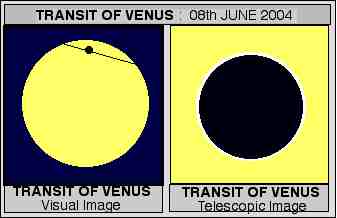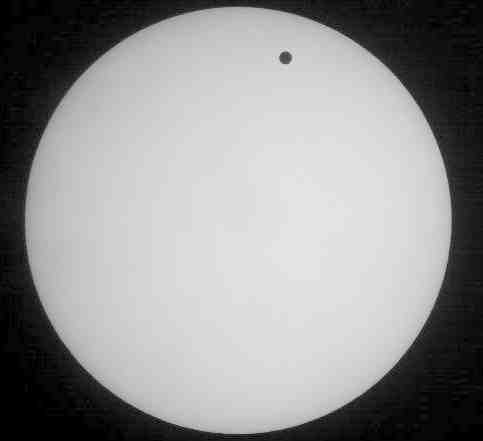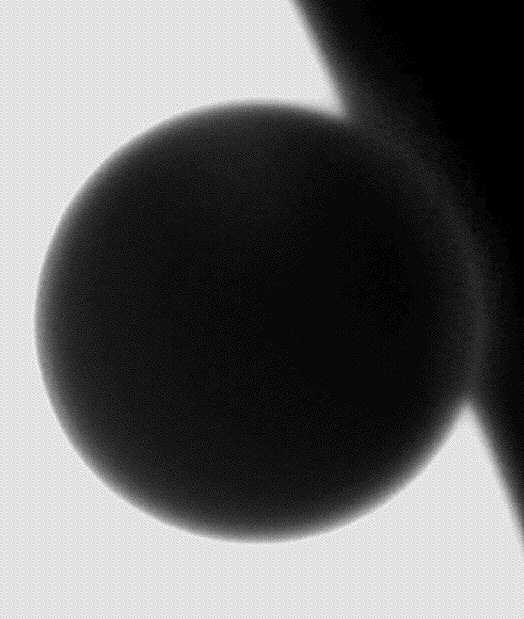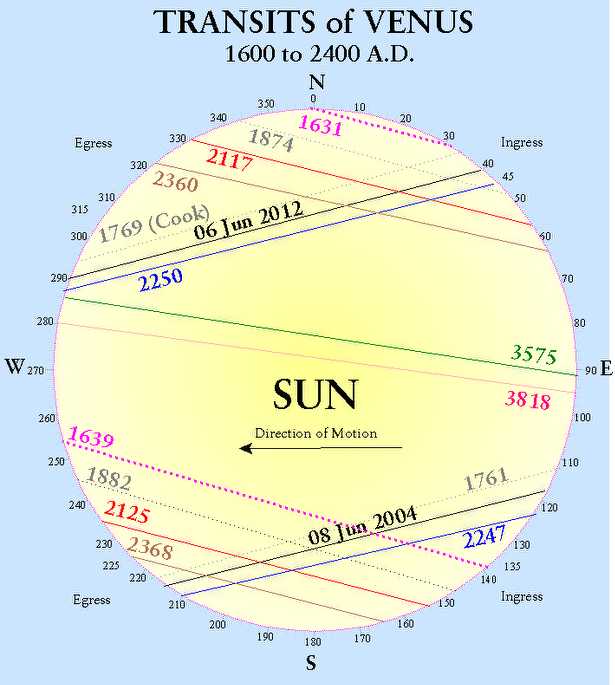



One of the most eagerly anticipated rare astronomical events is the so-called Transit of Venus where the planet is seen to cross the solar disk during inferior conjunction. Only the planets of Mercury and Venus can do so, by passing in our line of sight between the Earth and Sun. Transits are far rarer events compared to the relatively more common solar or lunar eclipses. Once every century Mercury may cross the Sun either thirteen or fourteen times, but for the planet Venus these occur in twice in pairs approximately 115 years apart, being 121.5 years between each successive series.
The geometry of the transit is fairly easy to understand. Mercury has more transit events than Venus. This is mainly because the orbital period is two-and-a-half times longer - being some 224.701 days for Venus compared to Mercury’ 87.969 days. Transits of Venus would be more frequent and occur once every planetary orbit if it were not for the 3.39o inclination orbital tilt of the planet to the ecliptic. This means that for transits to be seen from Earth, the intersection of the orbital plane to the ecliptic must be almost perfectly aligned with the Earth’s position in space. The necessary geometric alignment only allows this to happen either in December or June, when either the orbital descending node or ascending node intersects with the geocentric solar position. It should be noted that both these times are six months apart.
Since telescopic observations began, only six events could have been seen. These were in the pairs 1631, and 1639; and 1761 and 1769; and 1874 and 1882. Between each mutual series of transits, the months in which they happen is reversed. Hence the 1874 and 1882 events were in December, of those respective years. The next ones in 2004 and 2012 will be the reverse of this, with both occurring in June.
The first astronomer to ventured the prediction of this remarkable phenomenon was Johann Kepler in December 1629. He published an appropriate “celestial notice” that announced that Mercury and Venus, were going to make a solar transits on two specified days during the northern winter in December 1631. The first ever observed solar planetary transit seen was of Mercury by Gassendi. Yet the first predicted transit of Venus also took place just one month later. It was later shown though that the general circumstances made the phenomenon impossible to be observed from anywhere in Europe. This first pair of transits were not really properly observed nor recorded.
The next pair of transits of 1761 and 1769 were very much anticipated. It had been Edmund Halley (1656-1742) who figured out a new method to calculate the true distance between the Sun and the Earth which could also be used to determine the true dimensional scale of the Solar System. Calculations relied on several parameters which were quite poorly known at the time. By knowing both the velocity of Venus during the transit and the exact moments of the two contact events of Venus’ disk with the solar disk, the astronomical unit could calculated. The serious need for suitable observations of the phenomena was stated and first drafted in England. The calculations at the time showed that the entire first event could be seen throughout Europe and towards the east to India. The second could only be completed if the transit was observed somewhere in the unexplored regions of the South Pacific Ocean. The real implications of these observations held much importance to astronomers at the time. Several significant expeditions of great expense were quickly organised - especially one expedition to travel to the other side of the world to observe the second of these series of transits.
During the 7th June 1761 transit many useful observations were made from the European observatories. These were aided by six major expeditions attempted. For Halleys method to work, the results required some distance between locations, and for the ingress and egress of the transit to be observed with accurate timings.
The British Government approved and funded three main expeditions. One was placed on the island of St. Helena in the mid-Atlantic Ocean, that was lead by one of their most capable astronomers, Nevil Maskelyne. The second was made at the Cape of Good Hope in now South Africa, Charles Mason and Jeremiah Dixon. Another site was established in North America in Newfoundland, observed by a Professor at Harvard University, John Winthorp. The French also mounted three expeditions, but these journeys were attempted from far more difficult site. Travelling by land, Jean Cappe d’Auteroche observed during mid-winter from Tobolsk in Siberia Less known, but just as adventurous, was the French observation expedition lead by Alexandre-Gut Pingré to Rodriguez Island in the Indian Ocean, just east of Madagascar. The third expedition was to the French Colony of Pondicherry in India. This was lead by Guillaume Le Gentil, whose observations were thwarted, when he was prevented from landing there by the British, who were at war with the French.
One of the biggest limitations to observations was the war between England and France, which prevented co-operation between these two nations and restricted travel throughout the world. Of all the expeditions, d’Auteroche’s observation proved to be the most successful, with the others having problems either with the cloudy cover, weather or determining the moments of contact by Venus with the solar limb. Many of the observations that were made were not reduced until much later, when the astronomers could compare and reduce the observations. One of the incidental advantages of all these scientific expeditions were in the other science disciplines, such as geography, geology and botany.
Eight years later in 1769, the transit of Venus was considered of even greater importance. Although expeditions throughout the world in the 1761 transit gain results, it was realised that the obtained values were far too diverse to be used for a definitive solar parallax. Ie. 9.44±0.58arcsec (8.28 arcsec to 10.60 arcsec.) and some 7.4% too large. Considering that Halley predicted that the transit could be predicted to 0.015 arcsec, the number of expeditions doubled. The most ambitious was from the South Pacific Island of Tahiti, with an additional off-shoot being several voyages to explore the places and oceans lying in unknown parts of the southern hemisphere. It fell on the famed explorer Lieutenant James Cook, later Captain, to do the observations from Tahiti. This was achieved under trying conditions by Cook’s astronomer on the voyage, Charles Green. Lieutenant Cook later went on to European discovery of New Zealand and the east coast of Australia early in the next year. For this reason, the Transit of Venus holds special interest for both Australians and New Zealanders.
In the end, the application of all the classical Venus transit observations proved to be rather inaccurate than expected, but were sufficient enough to produce a rough measure of the estimated distance between Sun and the Earth to what now is called the Astronomical Unit. In regard of Venus, the distance being measured is the so-called solar parallax, which represents the apparent diameter of the Earth if it were placed at the very centre of the Sun exactly 1 AU away. This theoretical value is about 8.794 arcsec, defining the true scale of the Solar System. Today, the need for transit observations for the 2004 and 2012 events is little more than some celestial-oddity as the solar parallax can be achieved by other means. In the early 1960’s the application of radio-waves via radar was used to determine the exact distance of Venus at any instance. In more recent years, sensitivity of radio equipment we can use both Mercury and the Sun itself to determine the distance from Earth to the Sun.
The problem of the solar parallax has been on-going since the attempt made by the ancient astronomers like Aristarchus who measured and calculated the value around 3 arcmin. This continued to be adopted until Tycho. It was Johann Kepler, using Tycho’s observations, who determined the value of around 1 arcmin. By 1630, Vendelinus using a telescope found using the Aristarchus’ method measuring the time of the quarter-phased moon a new value of 15 arcsec - about a twelfth of what Aristarchus had found and about twice the present accepted value.
Other methods were applied other than Venus. One of the most significant was by observation from Paris by Cassini of Mars. Using the observed parallax of Mars against the background sky, he calculated that a value should be less than 10 arcsec, and assumed in his calculations the value of 9.5 arcsec. This is close to the modern values, but looking at Cassini’s data the error in an specific value was really about 50%.
The most significant development after Cassini was Edmond Halley. Although famous for his discoverer of the 76-year periodic nature of Halley’s Comet, his second achievement could arguably be his work on methods to determine the solar parallax. This time he suggested something experimentally different than the earlier lunar or solar parallaxes, oppositions of Mars and estimated of Venus’ solar conjunctions. Halley travelled to the island of St. Helena to observe the transit of Mercury.
One of the most remarkable things about the transit of Venus is the long time period between successive pairs of events. Since the invention of the telescope, each transit has seen a complete transformation in astronomy - both technically and knowledge.
For instance, the first events were seen prior to the invention of the telescope, while the prediction of the time of the event remained uncertain by a few days. The next transit series during the mid-18th Century was used for scientific expeditions that concentrated on Halley’s method to determine the solar parallax and the distance to the Sun. Not much interest was given to the various phenomena of the event, though it later proved the inexactitude of the times of the egress and ingress proved to be the “Achilles heel” of the result found for the solar parallax. This error was caused by the interaction of the Venusian atmosphere with the solar limb. The various phenomena seen during ingress and egress became one of the greatest of interest to the 19th Century, and understanding what was happening was considered important to tie down the exact times of contacts during the events. The addition of more powerful and quality telescopes certainly helped, and the final results moved closer to knowing the value of the solar parallax.
For the next transit our abilities, equipment and the knowledge means that observational questions raised by past observers should be finally answered. For amateurs, the question will be two-fold;
Although the Transit is steeped in history and has provided information very useful to astronomy, the amateur or professional astronomer can do very little to contribute to the science. Unfortuneately there is almost nothing amateurs can do can do these days except than just to look and enjoy the event. No doubt the best study of all almost the final astronomical achievement remaining is the application of CCD and astrophotographic imaging to record for prosperity the entire event. Taking CCD images of the ingress and egress of the planet crossing the disk is likely where most of the interests will be. Some observers may be looking for this elusive phenomena so that we can perhaps understand what the earlier observers were actually viewing!
For most of us, the thrill was/will be to see one of these the events actually happening and to think of the long history involved in the phenomena. No doubt, the even bigger thrill is the possibility of seeing the transit twice in ones lifetime. For the rest of our lives, no one alive today will ever see the Transit of Venus again.
 |
Figure 1. |
Observations of the 8th June 2004 transit from Australia was only seen in part, where on other side of the world throughout in the America’s, Africa and Europe, was seen in its entirety. The 2004 Transit of Venus was visible from eastern Canada and the U.S.A. Venus during the event subtended 61 arc-seconds, and was visible to the naked-eye using suitable dark filtration. This was the first transit of Venus in 121 years and was most eagerly anticipated.
From Sydney the skies were farly clear but the Sun was very close to the north-western horizon. The most anticipated of all the observations was seeing the appearance of Venus disk on the limb of the Sun. After hearing about the event for so many years the transit was thrilling. More interesting was seeing Venus slowly crawl across the solar disk - whose crossing clearly reminded me that the Solar System is not a static fixture, and that planetary bodies were real moving objects in a real dynamical system. This was real-time evidence that the planets travel with significant velocities.
 |
Figure 2. B/W Photo of Venus |
The transit event discern the jet black disk of the planet and was clearly seen to the naked-eye. This appeared at the very top of the Sun’ disk, whose dimensions can be seen in Figure 2. Poor atmospheric seeing did play havoc with the image on occassions, but for the most part proved inconsequential. The greyish aureole of Venus’ atmosphere was seen even in the 50mmm refractor and binoculars - though not visible to the naked-eye. As the Sun approached the north-western horizon, hanging I suppose by about 5o, the disk merged with the usual thick haze of city, turning into a yellowish-orange ball with a visible spot on the top of the Sun. For a few moments I was able to glace at the Sun and see completely unaided the planet Venus. This last sight is likely the most memorable off all and is something I’ll have trouble forgetting.
However, much of the observed phenomena seen in the last transit in the “pre-modern era” during the 1874 and 1888 certainly failed to live up to expectations. For example, much of the presupposed phenomena as reputed by H.C. Russell in 1874, was not seen at all. We can only assume that Russell and others had either imagined or conjectured their observations. This was especially regarding the interactions of the Venusian atmosphere with the the edge of the solar disk and its limb.
 |
|
Figure 3. |
The inital transit ingress was seen from
most of Australia and New Zealand, while the egress was
unfortunately to remain invisible.
{However, I have added its information below just for
completeness.}
From Sydney, the whole ingress took 19m 16.7 seconds or 1156.7 seconds. Although this figure did vary slightly from place to place, for most purposes, the differences were insignificant. In some ways it is best not to know, because this might aid a visual observation program of sorts. Few however timed the event. Features of the 2004 transit after the end of ingress were continuing for some to be seen perhaps as long as 30 minutes after this time. For most observers with the Sun fairly high in elevation saw the vestiges of the ‘black-drop’ for a few minutes but really nothing after this. (Perhaps the biggest disappointment of the while event.)
The movement of the disk proved to be less interesting than initially thought. Contact occurred at
The egress on the other hand was not seen except in Europe and Africa, but I did see this live on the Internet from there. Based on the geocentric data, the motion going out is 18.9% shorter, at 15min 56.7 min (956.7 seconds).
The second of the Venus transits will occur on 3rd June 2012. This time it will be visible in portions of the world that missed the 2004 event. From places like Australia and South-East Asia, observers will see the whole Transit.
All Venus transits show a general pattern of recurrence at intervals of 8 and 121.5 years, and 8 and 105.5 years. The following Table 1 (Below) lists all transits of Venus during a 700 year period from 1631 AD through 2368 AD. I have also attached two of the best transits in the distant 34th and 37th Century which will be the best in the next two millennia.
I have attached a drawing of Table 1 transits just for the reader‣ interest. Figure 3 image of the Sun is deliberately oval to make the paths of these transits clearer to see.
***********************************************
Date Time Chord PA PA
U.T. Length Ingress Egress
arcsec (o) (o)
***********************************************
07 Dec 1631 05h 18m +936 032 359
04 Dec 1639 18h 24m -529 139 254
07 Jun 1761 05h 19m -569 112 218
03 Jun 1769 22h 27m +610 034 295
09 Dec 1874 04h 02m +825 047 343
06 Dec 1882 17h 04m -639 147 245
08 Jun 2004 08h 19m -628 118 215
06 Jun 2012 01h 28m +553 040 291
11 Dec 2117 02h 48m +724 056 332
08 Dec 2125 16h 01m -733 154 235
11 Jun 2247 11h 43m -690 124 210
09 Jun 2255 04h 50m +492 045 288
13 Dec 2360 01h 52m +620 063 323
10 Dec 2368 14h 58m -829 164 224
10 Dec 2368 14h 58m -829 164 224
*********************************************
23 Dec 3575 21h 11m +131 091 286
(Good Transit)
25 Dec 3818 20h 27m +039 095 280
(Best Transit)
***********************************************

You would find during the same time of the mid-2004 transit, from Venus’s perspective, the Earth would be at the Venusian’s opposition, lying very close to the line of the ecliptic. Incidentally, if you could looking back at the Earth, you would see an exceedingly bright bluish “star” shining as a -6.46 magnitude in the zodiacal constellation of Ophiuchus. The position would be in a starry field void of many bright stars and some 3.6o NW of 3rd magnitude Theta (θ) Ophiuchi. Earth would be about 61.97arcsec across and would lie some 43.20 million kilometres (0.2888 AU) away. Our Moon would be 56.7″ arc minutes east of the Earth’s position (PA 100o) appearing as a -2.4 magnitude “star” and would subtend about 16.5arcsec across.
Easily separated by the naked-eye no doubt it would be an awe-inspiring spectacle and perhaps just as wonderful as a solar transit. Astronomers living on both planets no doubt were fairly joyous on 6th June 2004!
